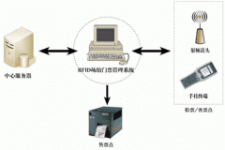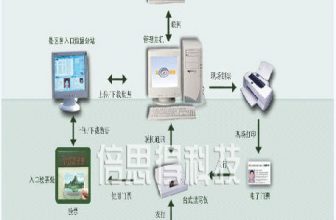
RFID ticket management system
[ad_1]
Ticket management system structure
The use of RFID technology for anti-counterfeiting of tickets not only eliminates the need for manual identification and realizes the rapid passing of personnel, but also identifies the number of times the tickets are used to prevent the tickets from being stolen and used again.

Figure 1 Schematic diagram of the structure of RFID stadium bill anti-counterfeiting system
The system consists of three parts: a back-end database, a ticket terminal, and a ticket reader, and each part is connected through a network system.
The back-end database is responsible for storing anti-counterfeiting information such as ticket holder information sent by the ticketing terminal
The ticketing terminal writes the relevant information of the ticket buyer into the electronic label attached to the ticket through the label printer, and uploads the information recorded in the label to the system database at the same time
The reader installed at the entrance of the venue is responsible for collecting the electronic label information in the bill, and completing the verification process by comparing it with the information recorded in the background database
Business Process of Bill Management System

Figure 2 Bill anti-counterfeiting business process
RFID ticket anti-counterfeiting process:
Information binding: RFID anti-counterfeiting bills can be made by RFID label printers. Each ticket has a unique and unchangeable ID number.
Ticket sales: When the ticket is sold, information such as the name of the ticket holder, the certificate number, the validity period and the number of validity of the ticket can be written in the RFID anti-counterfeiting ticket, which can be determined according to specific needs. The ID number of the sold bill will be added to the list of legal bills in the system database as a basis for verification.
Ticket verification: When it is necessary to verify the identity of the ticket holder in real time (such as an airport), the authenticity check of the ticket is similar to the authenticity check of the certificate, that is, the information in the ticket is read through the reader and the back-end database is read Relevant information is retrieved in the process and compared with the certificates and notes of the note holder.

Figure 3 Flow chart of ticket checking, checking and checking
Real-time monitoring and data analysis: After the ticket checking is completed, the RFID ticket checking device can upload the ticket checking information (including the ticket information of the check-in and check-out through the device, the ticket checking time, etc.) to the server in real time, and the data monitoring and analysis running on the server The software summarizes and analyzes the uploaded information. The server can monitor the ticket checking in real time.
For places where there is no need to verify the identity of the bill holder, the verification of the authenticity of the bill can be achieved through an open access control method. The holder of the bill goes to the entrance without taking out the bill. As long as the bill is within the range of the reader, the system can determine the authenticity and validity of the bill, and activate the alarm device according to the validity of the bill, or open and close the electronic door at the entrance. .
Bill management system business functions
Ticket identification: basic function, ticket identification through rfid reader
Audience tracking and positioning and query: Through the authorization of electronic tickets, the admission scope of the audience in each area of the venue is limited. When the audience enters a certain area, the information obtained is reported to the management system through the reader.Staff can inquire and locate
Key area security control: summarize and analyze the access information of key areas, so as to analyze the situation, time, frequency, etc. of personnel entering the area, and judge the security situation of the area
Regional data analysis: Analyze the type of personnel, flow rate, flow time and regularity of the area, and determine whether the area is due to excessive concentration of people1 and other reasons such as confusion and other unsafe factors, so as to make additional staff or start other channels for evacuation
Patrol management: It can cooperate with patrol management equipment to realize real-time monitoring of security personnel patrolling in various areas of the venue through ticket authorization, data reading, and query methods
System Features
RFID anti-counterfeiting bills can be made by RFID label printers. Each ticket has a unique and unchangeable ID number.
The system can monitor the ticket checking in real time, and use analysis tools to summarize and analyze all the data.
When a bill is sold, the ID number of the sold bill will be added to the list of legal bills in the system database as a basis for verification. In the RFID anti-counterfeiting bill, information such as the name of the bill holder, the certificate number, the validity period and the number of validity of the bill can be written, which can be determined according to specific needs.
It is suitable for ticketing occasions with a large number of people. By writing the number of uses in the label, “times anti-counterfeiting” can be realized
Advantages of bill management system
The advantages of the RFID bill anti-counterfeiting system are mainly manifested in the following aspects:
High security: The core of the electronic tag (RFID) is an integrated circuit chip with high security. Its security design and manufacturing determine that the threshold of RFID technology is high and it is not easy to imitate. The electronic tag has a unique ID number–UID. UID is solidified in the chip and cannot be modified or imitated; it has no mechanical abrasion and anti-fouling; in addition to the password protection of the electronic tag, the data part can be safely managed by encryption algorithms; read-write equipment There is a mutual authentication process with the label.
Improve ticket inspection efficiency: In terms of ticket anti-counterfeiting, the use of RFID electronic tickets instead of traditional manual tickets can also greatly improve the efficiency of ticket inspection. In large-scale sports competitions and performances where the ticket volume is relatively large, RFID technology is used to prevent counterfeiting of tickets. Manual identification is required to achieve rapid passage of personnel.
Prevent re-use: record the number of times the ticket enters and exits to prevent the ticket from being stolen and used again.
Real-time monitoring: real-time monitoring of the status changes of each RFID ticket during use.
[ad_2]




